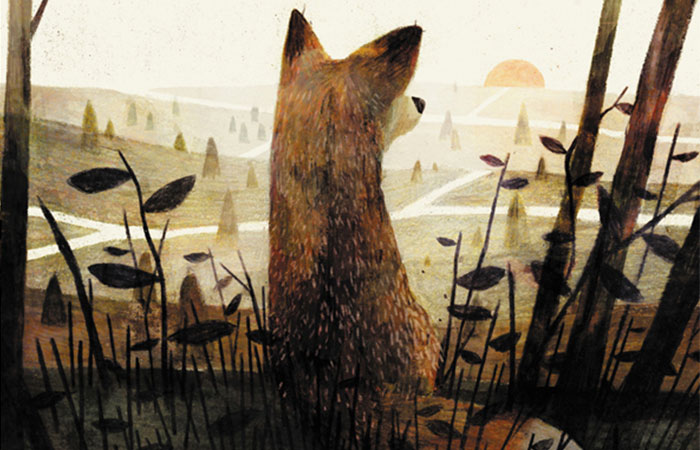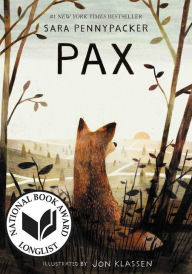The Timeless and Moving Pax is Your Next Favorite Middle Grade Read

In its simplest terms, Pax is: “The story of a boy, his pet fox, and the war that separates them.” But this book is so much more than that brief synopsis, and if that were all I knew about the novel, I probably wouldn’t pick it up of my own volition; and that would be a huge mistake. Through this particular story of one boy and one fox, the reader witnesses the larger themes of humanity, war, cruelty, and love.
The first chapter of this beautifully evocative middle-grade book by Sara Pennypacker (author of the Clementine series, and many others) packs a wallop. Twelve-year old Peter is forced by his father to set loose his beloved pet fox, Pax, because of the war. Peter immediately realizes that he’s made a big mistake and sets out to find Pax and bring him home. You know from the get-go that you, dear reader, are in for an emotionally charged journey, so grab some peanut butter crackers (in honor of Pax, who loves peanut butter), and a box of tissues, and hang on for the ride. Ms. Pennypacker will make sure that you won’t regret the journey.
Pax
Pax
By
Sara Pennypacker
Illustrator
Jon Klassen
In Stock Online
Hardcover $16.99
The story is told through alternating perspectives of Peter and Pax. Pax, as Peter knows, means peace, and is a particularly poignant name in a book about war. I confess I have never had any feelings one way or the other about foxes (perhaps because living in Brooklyn I have yet to run into one) and now I feel like I’ve been missing out. Red foxes are incredible animals, and from the acknowledgements it seems that the author did a deep dive into their world with the help of Matt Walter, a NY biologist and wildlife tracker. When you put down this book, you will probably want to go even further down that fox burrow.
It’s fascinating to see the way that the foxes describe the humans, which is raw and honest and painful and makes you look at our species and wonder who exactly the animals are. “Are they careless? They were careless when I lived with them…They plow a field and they slaughter the mice living there with no warning. They dam a river and leave the fish to die.” These perceptive animals also sense our fear, anger and pain, even though as humans we can pretend to be calm and controlled and happy. There is no lying with animals. (And perhaps children are similar in this way.) But as adults we often have two sides, two faces, a calm and controlled smile masking our inner turmoil.
It’s also interesting to see war described from a fox’s perspective, as a sickness. Pax, who, being a house pet, doesn’t know anything about living in the wild, or what war is, is told: “There is a disease that strikes foxes sometimes. It causes them to abandon their ways, to attack strangers. War is a human sickness like this.”
With plenty of adventure, danger, pitfalls, and some guidance from a sage veteran medic living in the woods, this book will keep you turning the pages hoping for the best for Peter and Pax on their journey, while perhaps in your gut fearing the worst.
“So which is it? You going back for your home or for your pet?” the medic asks. And as Peter and many of us who grew up among beloved pets know, “They’re the same thing.”
It’s a treat in a middle grade book to have illustrations—particularly when they are drawn by the uber-talented Jon Klassen (I Want My Hat Back). This book also uses my favorite paper stock, thick and with ragged edges. Even the chapter numbers—silhouette illustrations of the boy and the fox depending on whose perspective the chapter is being told through, are perfect. In many ways, the beauty in this book, in life, is in the details.
The word that kept creeping in as I was reading was timeless. This is a book that could have been written many years ago and years from today it will ring as true as it does now. I finished the last page with my cat purring and sleeping against my leg, and I admit it, I cried. (When I myself was a middle grade reader, I was sobbing over Charlotte’s Web, so you can only imagine the emotions this book stirred in me.) I’m not gonna lie, it’s at times a tough book. But it’s beautiful, and worth it.
This would be a really lovely story to read along with your kids, to share the experience of Pax together, and see where the resulting conversations take you. It took me only a day to read, and far longer to absorb. You know when you’re a kid and you read a book and it’s sad and beautiful and teaches you something about being human, and it just sticks with you (for me it was probably first The Giving Tree and then Bridge to Tarabithia)? Pax will be that book for many of this generation. What a gift.
Has your young reader met Pax?
The story is told through alternating perspectives of Peter and Pax. Pax, as Peter knows, means peace, and is a particularly poignant name in a book about war. I confess I have never had any feelings one way or the other about foxes (perhaps because living in Brooklyn I have yet to run into one) and now I feel like I’ve been missing out. Red foxes are incredible animals, and from the acknowledgements it seems that the author did a deep dive into their world with the help of Matt Walter, a NY biologist and wildlife tracker. When you put down this book, you will probably want to go even further down that fox burrow.
It’s fascinating to see the way that the foxes describe the humans, which is raw and honest and painful and makes you look at our species and wonder who exactly the animals are. “Are they careless? They were careless when I lived with them…They plow a field and they slaughter the mice living there with no warning. They dam a river and leave the fish to die.” These perceptive animals also sense our fear, anger and pain, even though as humans we can pretend to be calm and controlled and happy. There is no lying with animals. (And perhaps children are similar in this way.) But as adults we often have two sides, two faces, a calm and controlled smile masking our inner turmoil.
It’s also interesting to see war described from a fox’s perspective, as a sickness. Pax, who, being a house pet, doesn’t know anything about living in the wild, or what war is, is told: “There is a disease that strikes foxes sometimes. It causes them to abandon their ways, to attack strangers. War is a human sickness like this.”
With plenty of adventure, danger, pitfalls, and some guidance from a sage veteran medic living in the woods, this book will keep you turning the pages hoping for the best for Peter and Pax on their journey, while perhaps in your gut fearing the worst.
“So which is it? You going back for your home or for your pet?” the medic asks. And as Peter and many of us who grew up among beloved pets know, “They’re the same thing.”
It’s a treat in a middle grade book to have illustrations—particularly when they are drawn by the uber-talented Jon Klassen (I Want My Hat Back). This book also uses my favorite paper stock, thick and with ragged edges. Even the chapter numbers—silhouette illustrations of the boy and the fox depending on whose perspective the chapter is being told through, are perfect. In many ways, the beauty in this book, in life, is in the details.
The word that kept creeping in as I was reading was timeless. This is a book that could have been written many years ago and years from today it will ring as true as it does now. I finished the last page with my cat purring and sleeping against my leg, and I admit it, I cried. (When I myself was a middle grade reader, I was sobbing over Charlotte’s Web, so you can only imagine the emotions this book stirred in me.) I’m not gonna lie, it’s at times a tough book. But it’s beautiful, and worth it.
This would be a really lovely story to read along with your kids, to share the experience of Pax together, and see where the resulting conversations take you. It took me only a day to read, and far longer to absorb. You know when you’re a kid and you read a book and it’s sad and beautiful and teaches you something about being human, and it just sticks with you (for me it was probably first The Giving Tree and then Bridge to Tarabithia)? Pax will be that book for many of this generation. What a gift.
Has your young reader met Pax?
